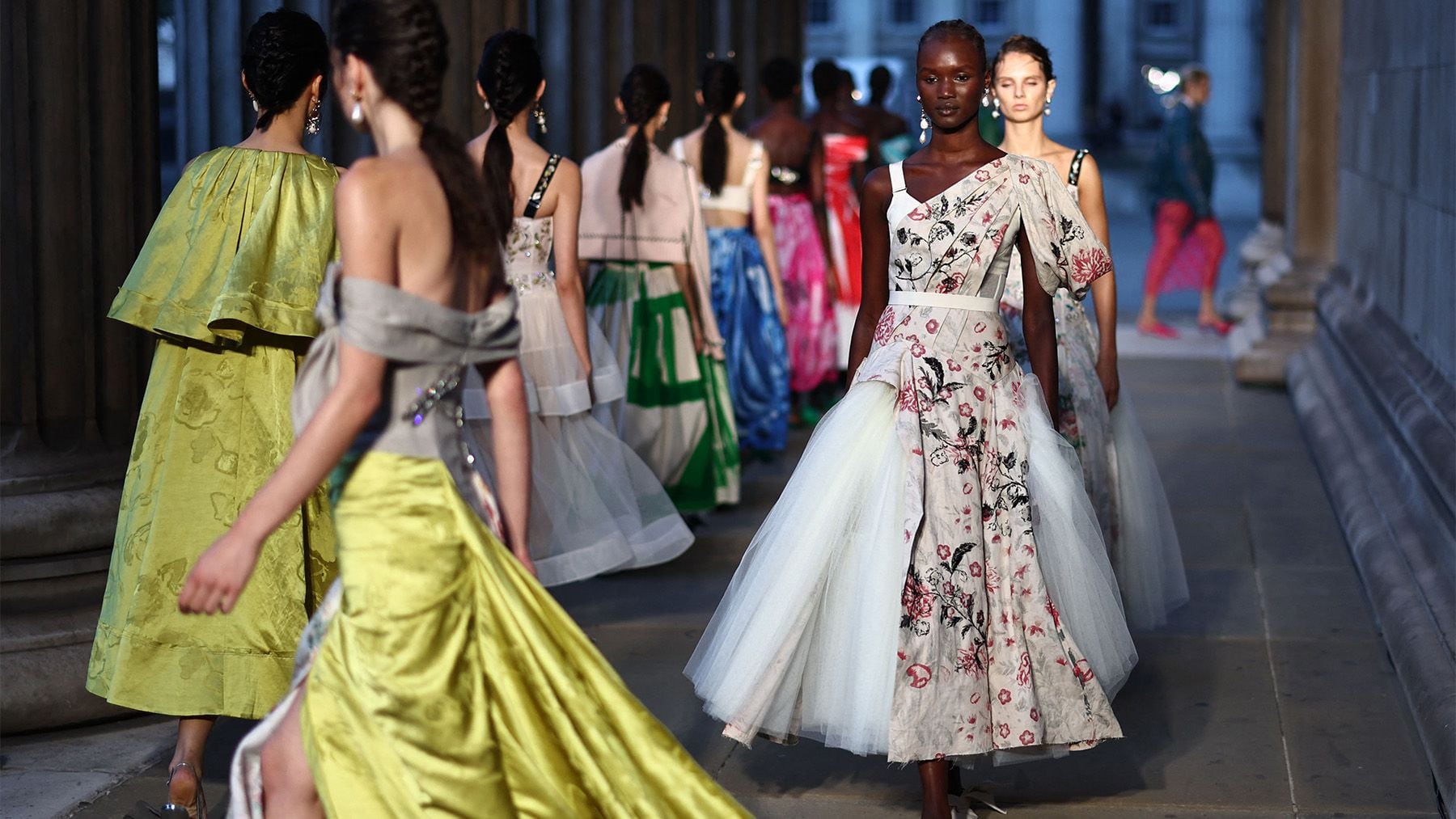At London Fashion Week, Mitfords and a Megabrand
LONDON — We racked up some serious mileage traversing London for the shows this season, but nowhere was further than Leamouth Peninsula in E14, home to the English National Ballet, where Simone Rocha staged what she titled a “Dress Rehearsal” in the ballet’s backstage area. The co-ed show was a rumination on fragility and lightness, “peeling off the layers of last season,” she said.
Rocha referenced Cy Twombly’s cake-shaped sculptures, and sure enough, the offering included cake-like dresses, festooned with bows and beading to resemble royal icing and real roses embedded into tulle gowns. Meanwhile, the menswear, rendered in technical nylon and satin, had a new sporty attitude. Overall, the results didn’t conjure up the powerful emotions that Rocha’s shows often can, but many of the looks had a sense of windswept, weatherproof reality that grounded them.
Erdem Moralıoğlu has been adept at working with British cultural institutions, and this time round, he turned to Chatsworth up in Derbyshire, the ancestral home of the Duke and Duchess of Devonshire, as he mined its sumptuous interiors and storied history. The Duchess of Devonshire, Deborah née Mitford Cavendish or “Debo” as she is fondly known, also informed the collection, which opened with a brilliant patchwork Barbour opera coat and ran through a gamut of eras, colliding Elvis embroidery (Debo was a fan of The King) and rich interiors-style textiles with prints featuring the stately home.
The Mitfords are a constant source of inspiration in fashion, but Moralıoğlu concentrated on the idea of textiles and heirlooms passed on through generations, and the outcome was powerful. The vibrant colour palette seen in the screen-printed gowns made the collection look anything but archival.
Emilia Wickstead could easily be gunning for the same clientele as Moralıoğlu. Her show was for the resort crowd who summer in the South of France in bright stripes, side-tie cocktail dresses and sailor suits. Accomplished and polite for her well-heeled customers. Ashish Gupta also knows his crowd, who were bang up for his return to the runway: a charming ode to London’s camp yesteryear. In a collaboration with Linder Sterling, it was a happy-go-lucky rainbow sparkle fest, offering light relief amid a week with no shortage of fashion earnestness.
Elsewhere, Yuhan Wang showed her strength in sultry cottage-core, with a collection inspired by Thomas Hardy’s heroine Tess of the d’Urbervilles. Ignoring the novel’s darker themes, Wang riffed off woodland animals and fruity embroideries. Cutesy country fantasy works for her. Masha Popova is also concentrating on her USP of overdyed denim in weird and wonky colours, and even as Y2K fashion begins to feel overplayed, her denim manipulation techniques are crying for a consultancy.
KNWLS is perhaps the buzziest of designers to have graduated from the Fashion East school, having just dropped a collaboration with Jean Paul Gaultier. Charlotte Knowles and partner Alexandre Arsenault were keen to further rev things up this season with a collection that was heavy on gnarly cracked leathers. All the better to showcase their signature moto jackets and corsetry.
Supriya Lele, like many of London’s designers, has opted to skip seasons and show when she feels ready to do so. Her return to the schedule this cycle was more than welcome, as her nuanced take on her Indian heritage was right on the money. The lines and drapes of a sari, salwar kameez and other traditional outfits, as seen on the women in her family, were echoed in sheer dresses paired with skinny flared trousers, anchored with 3D printed gold hardware. Swimwear poking out of low-cut skirts felt sharper than ever, even if hot girl summer clothes have been in the fashion ether for a while now. Revealing web-like knits added a new dimension to Lele’s ways of body definition. In her notes, Lele paid homage to London’s multiculturalism and her heritage, but those facets weren’t overly obvious in the clothes, and that felt refreshing.
Chet Lo also looked to his heritage, albeit in a more overt manner. Haam sap was the name of his collection, which in Cantonese literally translates into “dirty-minded” or “pornographic.” It’s a tough ask for a young designer to broaden out from a signature style, but Lo could stand to take a breather from his spikes to make way for more scope.
Anticipation for Daniel Lee’s sophomore runway show for British megabrand Burberry was ramped up by a series of headline-grabbing moves like rebranding Bond Street tube station as “Burberry Street.” Tying the brand to London can make for canny marketing, but the industry and Burberry’s client base are waiting for Lee’s magic touch with accessories. The show delivered Lee’s take on The Bright Young Things: cue beautiful knit fringe dresses paired with lightweight trenches in a two-tone tonic fabric. Flowers and fruits abounded in a zesty floral jacquard and a blue strawberry print. The Burberry check, so central last season, was replaced with a print that zooms in on the armour of the brand’s “Equestrian Knight Design.” The use of zippers suggested a stress on functionality. Crescent-shaped bags with heavy canvas straps were repeated throughout the show but didn’t have the kind of oomph many had hoped for. The last look was a model in Burbz blue trews, a giant equestrian knight belt and little more. Lads do like to go topless as soon as a whiff of sun comes out. But how does this fit with Burberry’s stated goal of elevating the brand?
The final fresher of the season was Aaron Esh, who came with hyped expectations. Up in the Blavatnik Wing of Tate Modern, the skyline of St. Paul’s Cathedral illuminated Esh’s subculture-infused tailoring. Let’s call it indie-sleek, as shrunken bomber jackets, narrow tux jackets, restrained puff skirts, and shawl-collared shirting hinted at hipster classics. It was a surprisingly sharp and well-honed offering from Esh, who immediately got retail traction after graduating in 2022. And so London’s youth rises again.

:quality(70):focal(1157x121:1167x131)/cloudfront-eu-central-1.images.arcpublishing.com/businessoffashion/DYCE5DUJHZEAJO7DG65GO4AREM.jpg)
